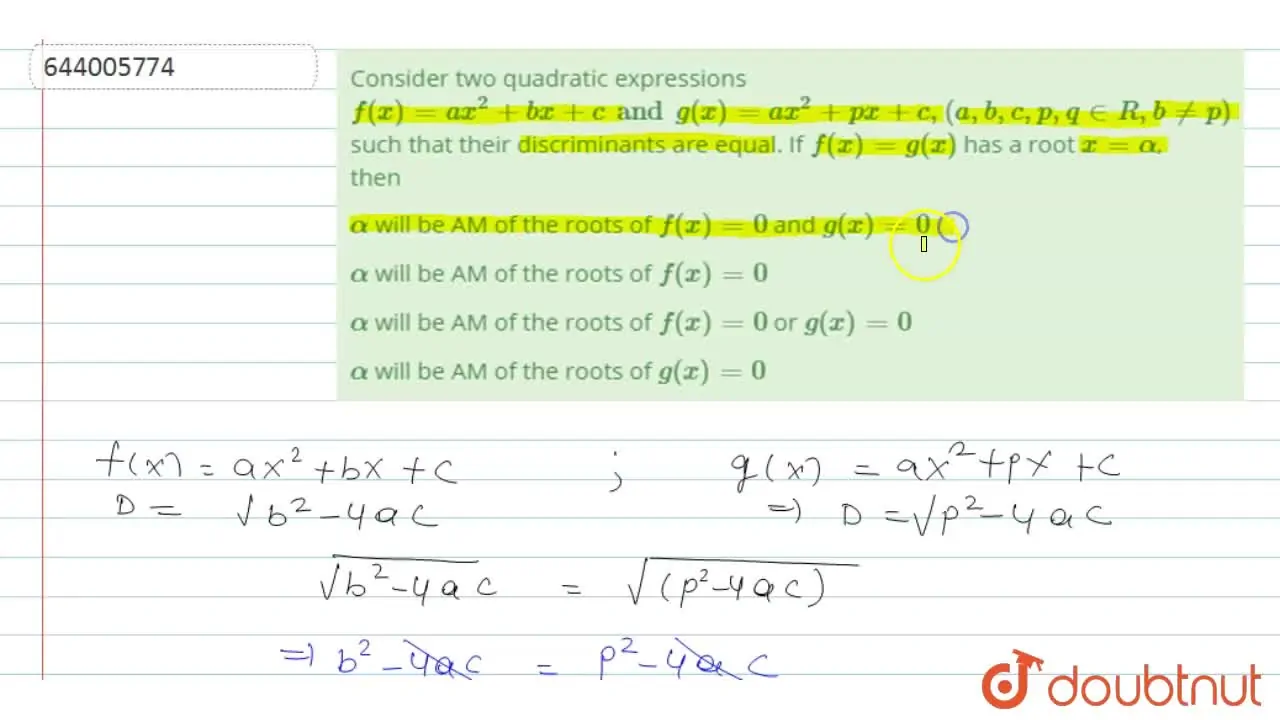Consider two quadratic expressions f(x)=ax2+bx+candg(x)=ax2+px+c,(a,b,c,p,q∈R,b≠p) such that their discriminants are equal. If f(x)=g(x) has a root x=α, then
α will be AM of the roots of f(x)=0 and g(x)=0
α will be AM of the roots of f(x)=0
α will be AM of the roots of f(x)=0 or g(x)=0
α will be AM of the roots of g(x)=0
The correct Answer is:A
Given b2−4ac=p2−4aq……….i
and f(x)=g(x)
⇒ax2+bx+c=ax2+px+q
⇒(p−p)x=q−c
∴x=q−cb−p=α [given (ii)]
From Eq. (i) we get
(b+p−)(b−p)+4a(q−c)=0
⇒(p+p)(b−p)+4aα(b−p)=0 [from Eq. (ii)]
or α=−(p+p)4a[∵b≠p]
=(−ba)+(−pa)4 ltrbgt =[Sum of theroots of(f(x)=0)+Sum of the roots of(g(x)=0)]4
=AM of the roots of f(x)=0
and g(x)=0
Related Playlists
- BOOK - ARIHANT MATHS ENGLISHCHAPTER - THEORY OF EQUATIONSEXERCISE - SCQ_TYPE1videos
THEORY OF EQUATIONS
- BOOK - ARIHANT MATHS ENGLISHCHAPTER - THEORY OF EQUATIONSEXERCISE - Exercise (More Than One Correct Option Type Questions)15videos
THEORY OF EQUATIONS
- BOOK - ARIHANT MATHS ENGLISHCHAPTER - THEORY OF EQUATIONSEXERCISE - Exercise For Session 510videos
THEORY OF EQUATIONS
- BOOK - ARIHANT MATHS ENGLISHCHAPTER - THE STRAIGHT LINESEXERCISE - Exercise (Questions Asked In Previous 13 Years Exam)17videos
THE STRAIGHT LINES
- BOOK - ARIHANT MATHS ENGLISHCHAPTER - THREE DIMENSIONAL COORDINATE SYSTEMEXERCISE - Three Dimensional Coordinate System Exercise 12 : Question Asked in Previous Years Exam2videos
THREE DIMENSIONAL COORDINATE SYSTEM
Similar Questions
Let f(x)=ax2+bx+c, g(x)=ax2+px+q, where a, b, c, q, p∈R and b≠p. If their discriminants are equal and f(x)=g(x) has a root α, then
View SolutionIf the equation x2+2x+3=0 and ax2+bx+c=0,a,b,c∈R, have a common root, then a : b:c is
View SolutionIf f(x) =ax2+bx+c and f(1)=3 and f(-1)=3, then a+c equals
View SolutionLet f(x)=ax2+bx+c, g(x)=ax2+qx+r, where a, b, c,q, r∈R and a<0. If α, β are the roots of f(x)=0 and α+δ, β+δ are the roots of g(x)=0, then
View SolutionLet f(x)=ax2−bx+c2,b≠0andf(x)≠0 for all x∈R. Then
View SolutionLet f(x)=x3+ax2+bx+c and g(x)=x3+bx2+cx+a, where a, b, c are integers. Suppose that the following conditions hold-
(a) f(1)=0,
(b) the roots of g(x) = 0 are the squares of the roots of f(x) = 0. Find the value of: a2013+b2013+c2013View SolutionIf P(x)=ax2+bx+c, and Q(x)=−ax2+dx+c,ax≠0 then prove that P(x),Q(x)=0 has atleast two real roots.
View SolutionIf f(x)=ax2+bx+c , where a≠0,b,c∈ R , then which of
the following conditions implies that f(x) has real roots?View SolutionIf the equations ax2+bx+c=0andx2+x+1=0 has one common root then a:b:c is equal to
View SolutionIf f(x)=axb and g(x)=cx2a , then g(f(a)) equals
View Solution


